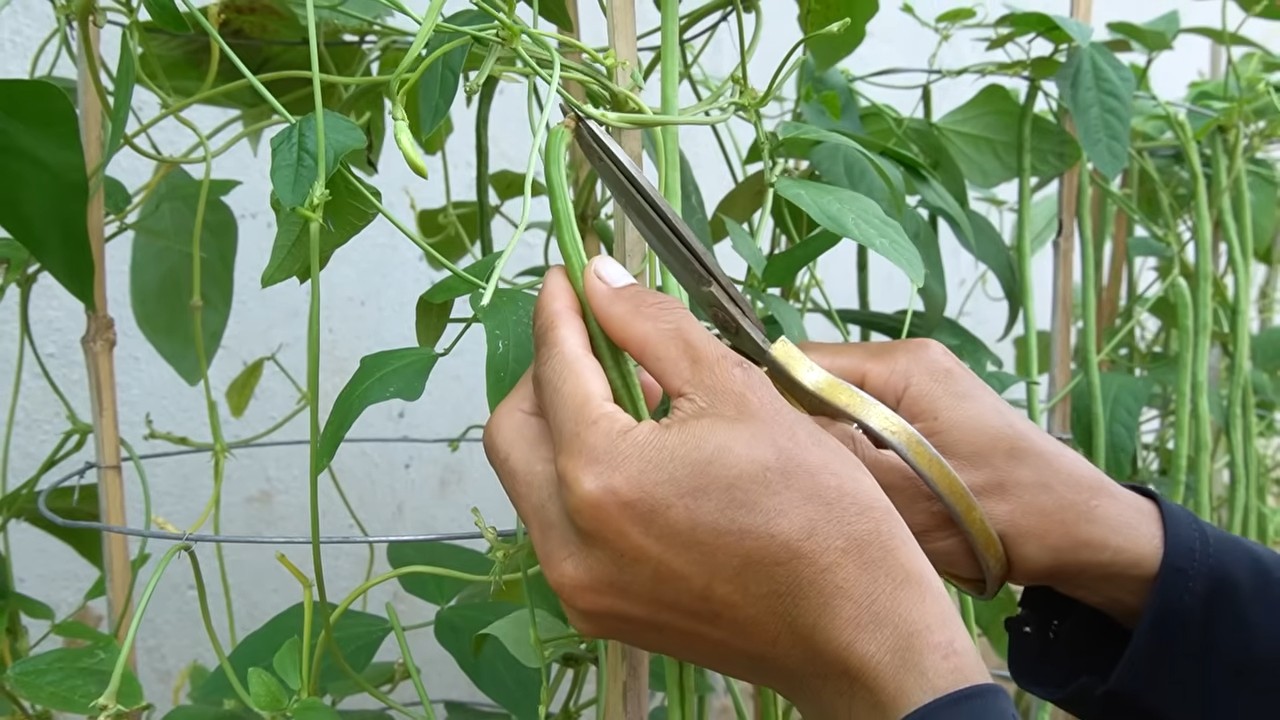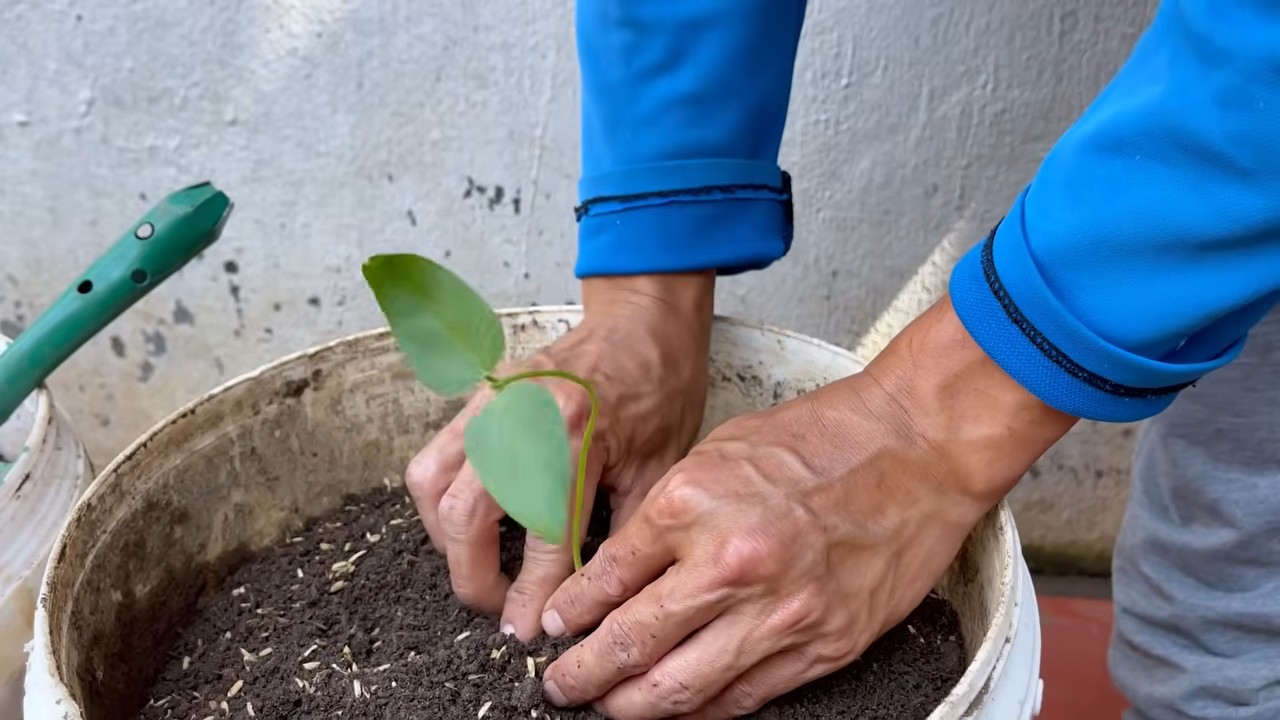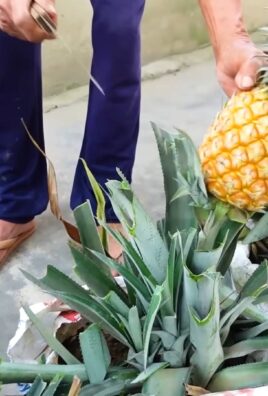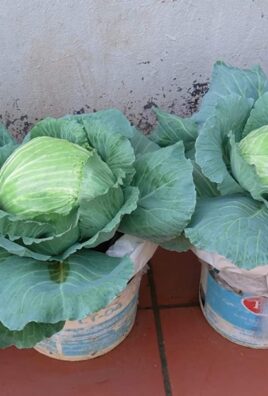Grow Long Beans Easily and transform your garden into a vibrant, bountiful haven! Have you ever dreamt of harvesting armfuls of those slender, delicious beans right from your own backyard? I know I have! There’s something incredibly satisfying about nurturing a plant from seed to table, and with long beans, the reward is both visually stunning and incredibly tasty.
Long beans, also known as yardlong beans or asparagus beans, have a rich history, particularly in Asian cuisine. For centuries, they’ve been a staple in stir-fries, curries, and salads, adding a unique texture and flavor. But beyond their culinary appeal, growing long beans is surprisingly easy, even for beginner gardeners.
In this DIY guide, I’m going to share some simple yet effective tricks and hacks that will help you grow long beans easily and successfully. Forget struggling with poor yields or pest infestations! I’ll walk you through everything from choosing the right variety and preparing your soil to providing the perfect support system and protecting your precious plants. Why spend money at the grocery store when you can enjoy fresh, organic long beans grown with your own two hands? Let’s get started and unlock the secrets to a thriving long bean harvest!

Grow Long Beans Like a Pro: My Foolproof DIY Guide
Hey there, fellow gardening enthusiasts! I’m so excited to share my tried-and-true method for growing long beans – those incredibly prolific and delicious veggies that can climb and sprawl their way into your heart (and onto your dinner plate!). I’ve experimented with different techniques over the years, and this is what consistently works best for me. Get ready to harvest a bumper crop!
What You’ll Need: The Essentials
Before we dive in, let’s gather our supplies. Having everything ready beforehand will make the process smooth and enjoyable.
* Long Bean Seeds: Choose a variety that suits your climate. I personally love the ‘Yard Long’ variety, but there are many others to explore.
* Well-Draining Soil: Long beans thrive in fertile, well-draining soil. You can amend your existing garden soil with compost or use a good quality potting mix if you’re growing in containers.
* Compost or Aged Manure: This will provide essential nutrients for healthy growth.
* Trellis or Support Structure: Long beans are climbers, so they need something to grow on. A trellis, fence, or even sturdy bamboo stakes will work.
* Gardening Gloves: Protect your hands from dirt and potential irritants.
* Hand Trowel or Garden Shovel: For planting and transplanting.
* Watering Can or Hose: To keep your plants hydrated.
* Optional:
* Seed starting trays and potting mix (if you’re starting seeds indoors).
* Organic fertilizer (for boosting growth).
* Mulch (to retain moisture and suppress weeds).
* Insecticidal soap (for pest control, if needed).
Phase 1: Starting Your Long Bean Seeds (Indoor or Direct Sowing)
You have two options here: starting your seeds indoors for a head start or directly sowing them into the garden. I usually opt for direct sowing unless I’m in a region with a very short growing season.
Option 1: Starting Seeds Indoors
This is a great option if you want to get a jump start on the growing season, especially if you live in a cooler climate.
1. Sow the Seeds: Fill your seed starting trays with a good quality seed starting mix. Make a small indentation (about 1 inch deep) in each cell and place one or two long bean seeds in each. Cover the seeds lightly with soil.
2. Water Gently: Water the trays gently to moisten the soil. Avoid overwatering, as this can lead to rot.
3. Provide Warmth and Light: Place the trays in a warm location (around 70-80°F) and provide plenty of light. A sunny windowsill or grow lights will work well.
4. Keep the Soil Moist: Check the soil regularly and water as needed to keep it consistently moist but not soggy.
5. Harden Off Seedlings: Once the seedlings have developed a few sets of true leaves (usually after 2-3 weeks), it’s time to harden them off before transplanting them outdoors. This involves gradually exposing them to outdoor conditions over a period of about a week. Start by placing them in a sheltered spot outdoors for a few hours each day, gradually increasing the amount of time they spend outside.
6. Transplant Seedlings: Once the seedlings are hardened off and the weather is warm enough (soil temperature above 60°F), you can transplant them into your garden.
Option 2: Direct Sowing
This is the easiest and most straightforward method, especially if you live in a warmer climate.
1. Prepare the Soil: Choose a sunny location with well-draining soil. Amend the soil with compost or aged manure to improve fertility.
2. Sow the Seeds: Sow the seeds directly into the ground, about 1 inch deep and 4-6 inches apart.
3. Water Gently: Water the soil gently to moisten it.
4. Keep the Soil Moist: Keep the soil consistently moist until the seeds germinate. Germination usually takes about 7-14 days, depending on the weather.
5. Thin Seedlings: Once the seedlings emerge, thin them to about 6-8 inches apart. This will give them enough space to grow and thrive.
Phase 2: Planting and Setting Up Support
Whether you started your seeds indoors or directly sowed them, this phase is all about getting your long beans established in their permanent home.
1. Choose a Sunny Location: Long beans need at least 6-8 hours of sunlight per day to thrive.
2. Prepare the Soil: Make sure the soil is well-draining and amended with compost or aged manure.
3. Install the Trellis or Support Structure: Before planting, install your trellis or support structure. This will give the long beans something to climb on as they grow. Make sure the structure is sturdy enough to support the weight of the mature plants. I’ve found that a simple A-frame trellis works wonders.
4. Plant the Seedlings or Thin Direct Sown Plants: If you started your seeds indoors, carefully transplant the seedlings into the garden, spacing them about 6-8 inches apart. If you direct sowed your seeds, thin the seedlings to about 6-8 inches apart.
5. Water Thoroughly: Water the plants thoroughly after planting.
6. Mulch (Optional): Apply a layer of mulch around the plants to help retain moisture, suppress weeds, and regulate soil temperature. I like to use straw or wood chips.
Phase 3: Caring for Your Long Bean Plants
This is where the magic happens! Consistent care is key to a bountiful harvest.
1. Water Regularly: Long beans need consistent moisture, especially during hot, dry weather. Water deeply and regularly, aiming for about 1 inch of water per week. Avoid overhead watering, as this can lead to fungal diseases. Drip irrigation is ideal.
2. Fertilize (Optional): If your soil is poor, you can fertilize your long bean plants every few weeks with an organic fertilizer. Follow the instructions on the fertilizer package. I often use a liquid seaweed fertilizer.
3. Train the Vines: As the long bean vines grow, gently train them to climb the trellis or support structure. You may need to tie them to the trellis with twine or plant clips.
4. Weed Regularly: Keep the area around your long bean plants free of weeds. Weeds can compete with the plants for nutrients and water.
5. Pest and Disease Control: Keep an eye out for pests and diseases. Common pests of long beans include aphids, bean beetles, and spider mites. You can control these pests with insecticidal soap or neem oil. Fungal diseases can be prevented by avoiding overhead watering and ensuring good air circulation.
6. Pinch Back Tips (Optional): Pinching back the tips of the vines can encourage bushier growth and more flowering. I usually do this when the vines reach the top of the trellis.
Phase 4: Harvesting Your Long Beans
This is the most rewarding part! Get ready to enjoy the fruits (or rather, the beans) of your labor.
1. Harvest Regularly: Long beans are ready to harvest when they are about 12-18 inches long and still tender. Harvest them regularly to encourage continued production.
2. Use Scissors or Pruning Shears: Use scissors or pruning shears to cut the beans from the vine.
3. Harvest in the Morning: Harvest the beans in the morning, when they are at their peak flavor.
4. Store Properly: Store the harvested beans in the refrigerator for up to a week.
5. Enjoy! Long beans can be eaten raw, steamed, stir-fried, or added to soups and stews. They’re incredibly versatile and delicious!
Troubleshooting: Common Long Bean Growing Problems
Even with the best care, you might encounter a few challenges along the way. Here are some common problems and how to address them:
* Poor Germination: This could be due to old seeds, cold soil, or overwatering. Make sure your seeds are fresh, the soil is warm enough, and you’re not overwatering.
* Yellowing Leaves: This could be a sign of nutrient deficiency, overwatering, or pest infestation. Check the soil pH, fertilize if needed, and inspect the plants for pests.
* Lack of Flowers: This could be due to insufficient sunlight, poor soil, or over-fertilization with nitrogen. Make sure your plants are getting enough sunlight, amend the soil with compost, and avoid over-fertilizing with nitrogen.
* Pest Infestation: Common pests include aphids, bean beetles, and spider mites. Control these pests with insecticidal soap or neem oil.
* Fungal Diseases: Fungal diseases can be prevented by avoiding overhead watering and ensuring good air circulation.
Extra

Conclusion
So, there you have it! Growing long beans doesn’t have to be a daunting task reserved for seasoned gardeners. With this simple, effective DIY trick, you can unlock the potential of your garden and enjoy a bountiful harvest of these delicious and versatile vegetables. This method offers a significant advantage over traditional planting, promoting healthier growth, maximizing space, and ultimately, yielding more long beans per plant.
Why is this DIY trick a must-try? Because it streamlines the growing process, making it accessible to everyone, regardless of their gardening experience. It addresses common challenges like limited space and inefficient nutrient delivery, leading to stronger, more productive plants. Imagine the satisfaction of harvesting your own fresh, crisp long beans, knowing you nurtured them from seed to table with your own hands.
But the beauty of gardening lies in its adaptability. Feel free to experiment with variations of this DIY trick to suit your specific needs and preferences. For example, if you live in an area with particularly hot summers, consider using a lighter-colored container to reflect sunlight and prevent the soil from overheating. You could also incorporate companion planting by adding herbs like basil or marigolds around your long bean plants to deter pests and attract beneficial insects. Another variation is to use different types of support structures. While a simple trellis works wonders, you could also try using bamboo poles or even repurposing old ladders to create a unique and visually appealing climbing frame for your long beans.
Don’t be afraid to get creative and personalize this DIY trick to make it your own. The key is to provide your long beans with the support they need to climb, adequate sunlight, and consistent watering. With a little bit of effort and this innovative approach, you’ll be well on your way to enjoying a plentiful supply of homegrown long beans.
We wholeheartedly encourage you to try this DIY trick for growing long beans. It’s a rewarding experience that connects you with nature and provides you with fresh, healthy food. Once you’ve given it a go, we’d love to hear about your results! Share your experiences, tips, and photos in the comments below. Let’s build a community of long bean enthusiasts and learn from each other’s successes and challenges. Happy gardening!
Frequently Asked Questions (FAQ)
What exactly *is* the DIY trick you’re referring to?
This article focuses on a specific method for growing long beans that emphasizes efficient space utilization and enhanced plant support. While the exact details of the trick would be found in the main body of the article (which is not provided here), it likely involves a specific type of container gardening, trellising technique, or soil amendment strategy designed to maximize long bean production. The core idea is to provide a structured and supportive environment for the long beans to thrive.
How much sunlight do long beans need?
Long beans are sun-loving plants and require at least 6-8 hours of direct sunlight per day to thrive. Insufficient sunlight can lead to stunted growth, reduced flowering, and a smaller harvest. Choose a location in your garden that receives ample sunlight throughout the day. If you’re growing long beans in containers, you may need to move them around to ensure they get enough sun.
What kind of soil is best for growing long beans?
Long beans prefer well-draining soil that is rich in organic matter. A slightly acidic to neutral pH (around 6.0 to 7.0) is ideal. Before planting, amend your soil with compost or well-rotted manure to improve its fertility and drainage. Avoid heavy clay soils, as they can become waterlogged and hinder root growth. If you have clay soil, consider growing your long beans in raised beds or containers with a suitable potting mix.
How often should I water my long bean plants?
Water your long bean plants regularly, especially during hot and dry weather. Aim to keep the soil consistently moist but not waterlogged. Water deeply at the base of the plants, avoiding wetting the foliage, which can increase the risk of fungal diseases. Check the soil moisture regularly by sticking your finger into the soil about an inch deep. If the soil feels dry, it’s time to water.
What kind of fertilizer should I use for long beans?
Long beans benefit from regular fertilization, especially during the flowering and fruiting stages. Use a balanced fertilizer with a ratio of 10-10-10 or 5-10-10. You can also use organic fertilizers such as compost tea or fish emulsion. Avoid over-fertilizing, as this can lead to excessive foliage growth at the expense of flower and fruit production. Follow the instructions on the fertilizer packaging carefully.
How do I support my long bean plants?
Long beans are climbing plants and require a support structure to grow properly. A trellis, fence, or bamboo poles can all be used to support the plants. Install the support structure before planting the long beans to avoid disturbing their roots later on. As the plants grow, gently guide the vines onto the support structure and tie them loosely with twine or plant clips.
When can I harvest my long beans?
Long beans are typically ready to harvest about 60-70 days after planting. Harvest the beans when they are young and tender, before the seeds inside become too large and tough. The beans should be about 12-18 inches long and about the thickness of a pencil. Harvest regularly to encourage continued production.
Are there any common pests or diseases that affect long beans?
Yes, long beans can be susceptible to various pests and diseases, including aphids, bean beetles, spider mites, and fungal diseases like powdery mildew. Monitor your plants regularly for signs of infestation or disease. Use organic pest control methods such as insecticidal soap or neem oil to control pests. Ensure good air circulation around the plants to prevent fungal diseases. Remove any infected leaves or plants promptly to prevent the spread of disease.
Can I grow long beans in containers?
Absolutely! Growing long beans in containers is a great option, especially if you have limited space or poor soil. Choose a large container that is at least 12 inches deep and wide. Use a well-draining potting mix and provide a support structure for the plants to climb. Water and fertilize regularly, and ensure the plants receive plenty of sunlight.
What are some good companion plants for long beans?
Companion planting can help to improve the growth and health of your long bean plants. Some good companion plants for long beans include basil, marigolds, rosemary, and nasturtiums. These plants can help to deter pests, attract beneficial insects, and improve soil health. Avoid planting long beans near onions or garlic, as they can inhibit their growth.




Leave a Comment